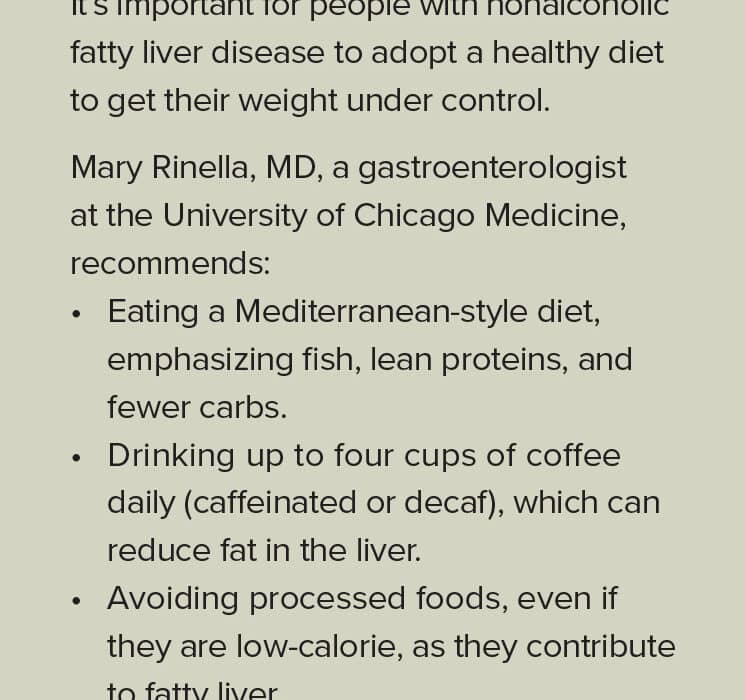Controlling fatty liver disease starts with losing weight
Danielle Dawson, 44, was shocked to learn in July 2020 that she had fatty liver disease. The hairstylist and married mother of three in Sandwich, Illinois, had expected her doctor to tell her the right-side pain she’d been having was due to gallbladder or digestive system problems. “It never occurred to me it would be my liver,” Dawson says.
For one thing, she associated liver problems with heavy drinking. But Dawson was only an occasional social drinker. “I’m like, hang on a minute: I don’t really drink a lot of alcohol. So how does that happen?”

Photo by Taylor Oak Photography
She also didn’t consider herself particularly overweight — at 181 pounds on a 5-foot-7-inch frame — which would put her at increased risk of the disease.
Yet, her doctor explained that she had nonalcoholic fatty liver disease (NAFLD), a condition in which fat accumulates in the liver. The disease put her at risk for developing cirrhosis, or scarring of the liver. And cirrhosis could mean she’d need a liver transplant or could even die.
“I thought, ‘Holy crap!’ It scared me. This is my health, and I need to do what I can to make it better,” Dawson says.
The dangers of fatty liver disease
Dawson is not the only person to feel stunned by a diagnosis of nonalcoholic fatty liver disease, which many people are unaware of, despite it being relatively common.
About 25% to 30% of Americans over age 15 — more than 80 million people — have nonalcoholic fatty liver disease, according to 2017 research led by the Center for Disease Analysis, a public health firm that studies disease. Scientists project that at least 100 million people will be diagnosed by 2030, a number that is rising along with America’s obesity rate.
It’s important to catch nonalcoholic fatty liver disease early, before the damage is irreversible. People can reverse the disease or keep it in check by losing excess weight.
“I’m like, hang on a minute: I don’t really drink a lot of alcohol. So how does that happen?”
There are several steps in the progression of the disease. When fat collects in the liver, where it should not be, the diagnosis is NAFLD.
When there’s also inflammation and liver damage, the condition is called nonalcoholic steatohepatitis, or NASH. About 25% of people with NAFLD develop NASH. In this subtype, the liver is inflamed and “the development of scarring is already starting,” says Mary Rinella, MD, a gastroenterologist who directs the metabolic and fatty liver program at the University of Chicago Medicine.
People with NASH are at increased risk of developing cirrhosis, a serious condition that involves scarring and permanent liver damage. When scar tissue takes over more of the liver, it’s harder for the liver to clear toxins from the blood and process nutrients.
As cirrhosis progresses, the liver has difficulty functioning, making a transplant the only recourse.
When the liver is “completely scarred up, there’s no cure for that,” explains Kavita Singh, MD, division head of gastroenterology for NorthShore University HealthSystem. “You’re talking liver transplant and a complete downward spiral in people’s quality of life.”
Cirrhosis also can lead to liver cancer. In addition, Rinella says, having fatty liver disease raises the risk of developing non-liver cancers, such as colon or kidney cancer, and cardiovascular disease.
What you can do about fatty liver disease
Not everyone who is overweight or obese develops fatty liver. However, obesity — especially excess weight in the belly, called visceral fat — and conditions such as diabetes and hypertension drive fatty liver disease, Rinella says.
“Eating excess calories causes fat to build up in the liver,” Rinella says. “When the liver does not process and break down fats as it normally should, too much fat will accumulate.”
Fatty liver disease also can occur without obesity, although that’s less common, Singh says. Other causes include genetics and various medical conditions, such as sleep apnea, hypothyroidism, and autoimmune disorders.
While NAFLD is more common in men overall, the disease accelerates in women after menopause due to hormones and other factors, Rinella says.
Early detection of fatty liver disease is tricky. “A lot of people have no symptoms,” Singh says.
Dawson was lucky to have pain that brought her condition to light. Often, physicians find the disease only incidentally, during routine bloodwork or tests for other problems.
“We need increased awareness at all levels,” Rinella says, calling for more public education and screenings.
No medications are currently approved by the Food and Drug Administration for fatty liver disease. However, with more than 200 clinical trials underway, and several drugs in late-phase development, it’s highly likely there will be an approved drug for NAFLD in the next few years,
Rinella says. She advises people with liver scarring to seek a clinical trial for access to such drugs.
Weight loss is the chief way to fight fatty liver, Singh says. Losing 7% to 10% of your body weight may reduce liver fat, inflammation, and scarring.
Some people with obesity may choose weight-loss surgery. If they can keep the weight off, it may reverse NAFLD or NASH, Rinella says.
It’s also important to get diabetes, cholesterol, and blood pressure under control, as these conditions promote fat deposits in the liver or worsen existing fatty liver.

Dawson has more work ahead, though. Her liver function tests haven’t improved as much as she’d hoped, possibly due to an autoimmune thyroid condition that could contribute to her liver disorder.
Discouraged by this lack of progress, Dawson says she ditched the diet for a week, then realized how much more physical and mental energy she had while on her healthy eating plan.
Now, Dawson says she can’t imagine returning to her old lifestyle. “I have to stick with this. I feel so much better,” she says. She’s not only protecting her liver, she’s protecting her life.
Originally published in the Spring/Summer 2022 print issue.

Lorna Collier is a health and education writer whose articles have appeared in the Chicago Tribune, Next Avenue, USNews.com and many others.












